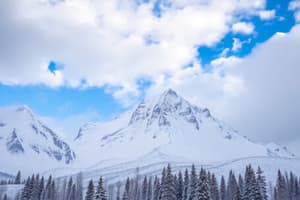Podcast
Questions and Answers
What atmospheric condition is typically associated with sinking air?
What atmospheric condition is typically associated with sinking air?
- Wet conditions
- Cloud formation
- Dry conditions (correct)
- Converging air
The amount of heat energy in the atmosphere depends on what primary factor?
The amount of heat energy in the atmosphere depends on what primary factor?
- The amount of insolation (correct)
- The distance from the sun
- The speed of the wind
- The density of the air
How does the angle at which the sun's rays strike the Earth's surface affect temperature?
How does the angle at which the sun's rays strike the Earth's surface affect temperature?
- The angle has no significant impact on surface temperature.
- A steeper angle concentrates the energy over a smaller area, resulting in higher temperatures. (correct)
- A steeper angle causes more reflection and scattering of sunlight, resulting in cooler temperatures.
- A shallower angle concentrates the energy over a smaller area, resulting in higher temperatures.
What is the primary mechanism by which winds transfer heat energy from the tropics to higher latitudes?
What is the primary mechanism by which winds transfer heat energy from the tropics to higher latitudes?
How do ocean currents contribute to the poleward transfer of energy?
How do ocean currents contribute to the poleward transfer of energy?
Which of the following best describes the movement of air associated with the subtropical high-pressure belt?
Which of the following best describes the movement of air associated with the subtropical high-pressure belt?
What is a primary characteristic of the equatorial low-pressure belt?
What is a primary characteristic of the equatorial low-pressure belt?
Which of these statements accurately describes the relationship between pressure belts and latitude?
Which of these statements accurately describes the relationship between pressure belts and latitude?
How do easterly winds in the Northern Hemisphere (NH) and Southern Hemisphere (SH) relate to the equatorial low?
How do easterly winds in the Northern Hemisphere (NH) and Southern Hemisphere (SH) relate to the equatorial low?
What is the main characteristic of the air found at the polar high?
What is the main characteristic of the air found at the polar high?
What role do westerly winds play in global circulation?
What role do westerly winds play in global circulation?
What drives the arrangement of pressure in belts of high and low pressure?
What drives the arrangement of pressure in belts of high and low pressure?
What is the Intertropical Convergence Zone (ITCZ) directly associated with?
What is the Intertropical Convergence Zone (ITCZ) directly associated with?
Flashcards
Latitude and Sun's Rays
Latitude and Sun's Rays
The angle at which the sun's rays strike the Earth's surface.
Insolation and Heat
Insolation and Heat
The amount of heat energy in the atmosphere depends on the amount of incoming solar radiation, which is called insolation.
Equator Heat
Equator Heat
Places near the equator receive more direct sunlight, leading to higher temperatures.
Wind and Heat Transfer
Wind and Heat Transfer
Signup and view all the flashcards
Ocean Currents and Heat Transfer
Ocean Currents and Heat Transfer
Signup and view all the flashcards
Ocean Gyres
Ocean Gyres
Signup and view all the flashcards
Water Density and Circulation
Water Density and Circulation
Signup and view all the flashcards
Poleward Heat Transfer
Poleward Heat Transfer
Signup and view all the flashcards
Equatorial Low
Equatorial Low
Signup and view all the flashcards
Subtropical High
Subtropical High
Signup and view all the flashcards
Subpolar Low Pressure (SPLP)
Subpolar Low Pressure (SPLP)
Signup and view all the flashcards
Polar High
Polar High
Signup and view all the flashcards
Easterly Winds
Easterly Winds
Signup and view all the flashcards
Westerly Winds
Westerly Winds
Signup and view all the flashcards
Polar Easterlies
Polar Easterlies
Signup and view all the flashcards
Global Wind Patterns
Global Wind Patterns
Signup and view all the flashcards
Study Notes
Temperature and Pressure Systems
- Low Pressure (LP): High temperature, rising air, converging air, clockwise movement, cloud formation, and wet conditions.
- High Pressure (HP): Low temperature, sinking air, diverging air, anti-clockwise movement, dry conditions.
- Cyclones: Low pressure systems with rising air, converging air, and clockwise rotation in the Northern Hemisphere; associated with cloud formation and wet conditions.
- Anticyclones: High pressure systems with sinking air, diverging air, and counter-clockwise rotation in the Northern Hemisphere; associated with dry conditions.
Unequal Heating of the Atmosphere
- Earth is heated by incoming solar radiation (insolation).
- The amount of heat energy in the atmosphere depends on insolation, which varies based on latitude and season.
- Insolation is affected by latitude (angle at which sunlight strikes the Earth's surface) and season (the Earth's tilt relative to the sun).
Latitude
- The angle at which the sun's rays strike the Earth's surface varies with latitude.
- Higher latitudes receive solar radiation at a lower angle, resulting in a larger surface area covered by the same amount of energy, leading to less heat energy per unit area.
- Lower latitudes receive solar radiation at a steeper angle, resulting in a smaller surface area covered by the same amount of energy, leading to more heat energy per unit area.
Unequal Heating and Seasons
- Seasons are caused by the tilt of the Earth's axis relative to its orbital plane around the sun.
- In the northern hemisphere, winter occurs when the Earth's axis is tilted away from the sun.
- In the southern hemisphere, winter occurs when the Earth's axis is tilted towards the sun
Heating Imbalances Due to Latitudinal Differences
- Incoming solar radiation and outgoing radiation are not balanced everywhere on Earth.
- Some areas receive more radiation than they lose (surplus), while others lose more radiation than they gain (deficit).
- The amount of radiation surplus equals the amount of radiation deficit, balancing the overall energy on Earth.
Mechanisms Responsible for Poleward Transfer of Energy
- Winds: Warm, moist air moves from the tropics to the poles, carrying heat energy.
- Ocean currents: Currents in oceans transport warm water to colder regions and vice versa, transferring heat energy.
- Deep ocean currents: Driven by differences in water density (cold, salty water is denser), these currents further contribute to the Earth's heat distribution.
Currents
- Surface currents: In the Northern Hemisphere, these currents circulate clockwise, and in the Southern Hemisphere circulate counter-clockwise.
- Warm and cold currents transport warm water towards the poles and cold water toward the equator, respectively.
Energy Transfer by Wind
- Wind is moving air that transports heat from lower to higher latitudes.
- Winds are part of the global circulation.
- Winds redistribute heat from the tropics to the poles.
Unicellular Model of Global Circulation
- The model depicts three large-scale atmospheric circulation patterns on Earth: Hadley, Ferrel, and Polar cells.
World Pressure Belts
- Pressure belts are arranged in an alternating pattern of high and low pressure around the Earth.
- These variations are associated with temperature differences.
- The pressure belts form distinct patterns in each hemisphere, which are similar but not identical. This is due to interactions of air circulation.
Three-Cell Circulation Model
- Equatorial Low: A region of low pressure associated with rising air near the equator.
- Subtropical Highs: Regions of high pressure associated with sinking air in the subtropics, leading to clear skies and little precipitation.
- Polar Low/Polar Highs: Regions of low pressure associated with rising, cold air near the poles; high pressure is associated with sinking, dense, cold air.
Three-Cell Circulation Model - Surface Winds
- Easterly winds: Tropical easterlies form part of Hadley cells and blow from tropical high pressure belts toward low pressure near the equator.
- Westerly winds: Part of the Ferrel cells and blow from the sub-tropical high-pressure belts towards the sub-polar low-pressure belts in both hemispheres.
- Polar easterlies: Originate from the polar cells and blow toward the subpolar lows.
Additional Features
- Global Circulation: The large-scale movement of air around the Earth, driven by temperature differences.
- Tropopause: The boundary between the troposphere and the stratosphere in the atmosphere.
- Global Winds: Prevailing wind patterns like the trade winds, westerlies, and polar easterlies across the globe.
- Latitude and Temperature: The amount of solar energy received varies across different latitudes, which affects local temperature.
- Pressure Belts and Winds: The pressure belts influence wind patterns due to pressure gradients.
Studying That Suits You
Use AI to generate personalized quizzes and flashcards to suit your learning preferences.




